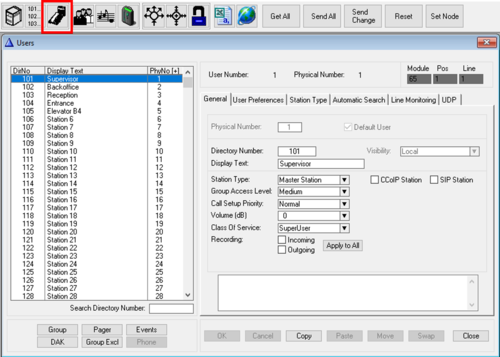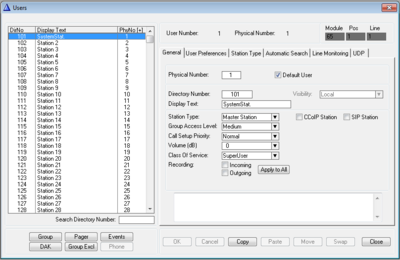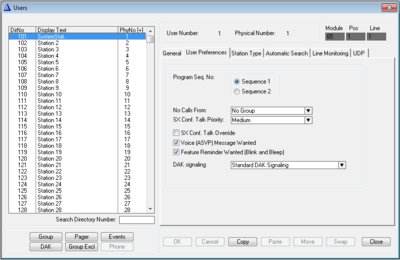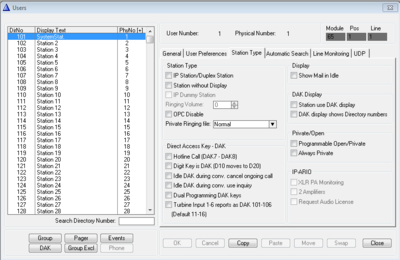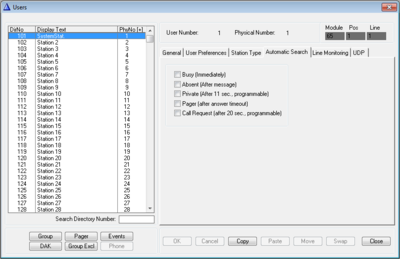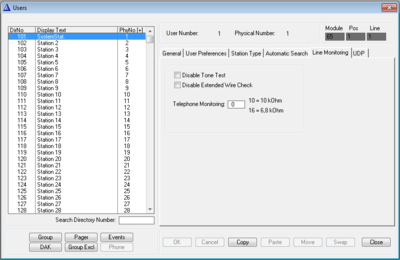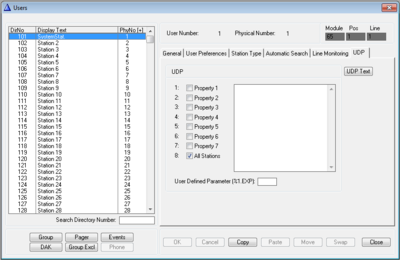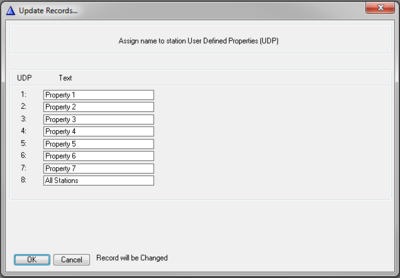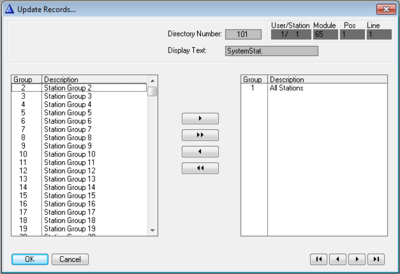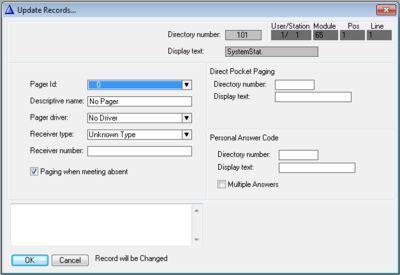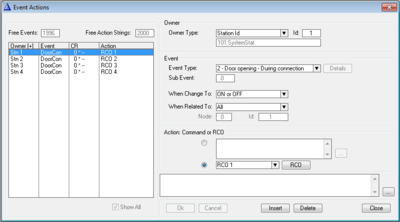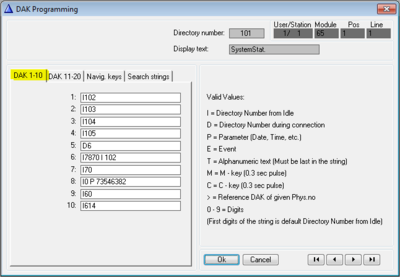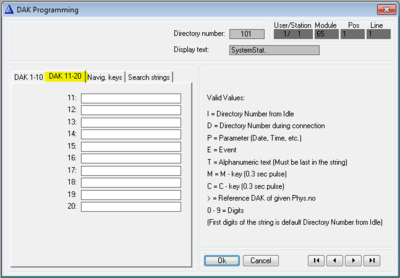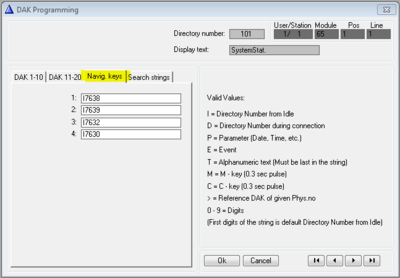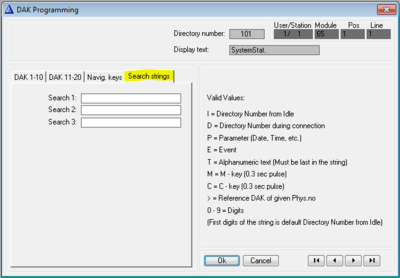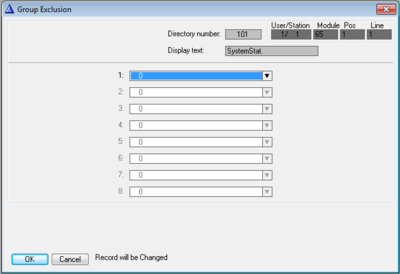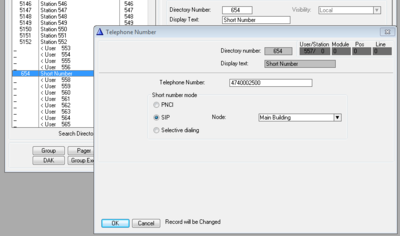Users & Stations (AlphaPro)
From Zenitel Wiki
From the Users & Stations window you can modify the properties of intercom stations.
Common information
The Users & Stations window contains some information which is available regardless of which tab has been selected:
- User Number: Range 1 - 600. The Directory Number of a station is linked to the User Number, which is linked to the Physical Number. By default there is a 1 to 1 link between User Number and Physical Number.

|
{{{1}}} |
It is possible to define several Users on the same Physical Number. This makes it possible for one station to have several Directory Numbers. This type of configuration is by default disabled, but can be enabled be selecting from the main menu bar View > Users&Stations: Allow editing of physical numbers.
- Physical Number: Range 1 - 552. Each intercom station has a physical number. For analog intercom stations the physical number is determined by the position of the line board (ASLT or ATLB-12), and in case of MultiModule system it is also determined by which module the line board is located. For IP intecom stations the physical number is a virtual number. The physical number is linked to the "User Number", which is linked to the Directory number.
- Module, Pos, Line: Shows where an analog station is physically connected. The numbers are automatically calculated from the physical number. Module shows which of the 4 modules (65-68) in a MultiModule system, Pos shows the line card position (1-23), and Line shows which of the 6 line circuits on the ASLT line card the station is connected to.
- Search Directory Number: Type in a directory number you are seaching for, and the listbox will be sorted as you type in the number.
- Sorting the listbox: Click on one of the headers in the listbox DirNo, Display Text or PhyNo to sort the list according tho the selected choice. By default the list is sorted on increasing physical numbers.
General tab
- Physical Number: Range 1 - 552. Each intercom station has a physical number. For analog intercom stations the physical number is determined by the position of the line board (ASLT or ATLB-12), and in case of MultiModule system it is also determined by which module the line board is located. For IP intecom stations the physical number is a virtual number. The physical number is linked to the "User Number", which is linked to the Directory number.
- Directory Number: The number to dial to call to the station. The directory number can be any 1 to 8 digit number.
- Display Text: This text will show in the stations display in idle, and is used as Caller ID when a call is set up. Maximum 16 characters. Depending on station type, and the number of digits in the directory number, the whole text might not be visible in the display of the station.
- Station Type: Select the type of station/device that is connected to the actual physical number. The following options are available:
- Master Station (default): Can be used for all master stations with full keypad
- Substation: Prevent the station from receiving Call Back mail (which will generate annoying blink and bleep in the station).
- Used for stations without full keypad (e.g. one or two call buttons)
- PA-interfaces (e.g. TKIS-2, TKIE-2, FBSAR) or IG-60 Amplifier
- IP Speakers
- PNCI - used for connection of external telephone lines.
- If you select PNCI (Public Network Interface) as the station type, you will get a help dialog box to remind you what to program in the AlphaCom exchange to make the PNCI work. Remember that the PNCI itself also has to be programmed. You do this from a terminal connected to the PNCI.
- CRM - Best option when using a station for Call Queueing (Call Request). Suitable setting for any IP Master station, and for the analog CRM IV or analog Dual Display station.
- IP Stations set as CRM type station will have backlight on permanently
- Display station - this option provides faster detection of line errors. Can only be used with display stations.
- DualDisplay - should be set for DualDisplay stations (1007007000/1008007000)
- Custom 2 - for future use
- CCoIP Station: Enable this flag when an IP Station is assigned to the physical number, set which codec to use (default is "Best Available") and the 'Packet size' (default is 20 ms). By default the IP Station will register with the directory number. If the Reg. w/Directory Number option is unchecked the MAC address of the station must be filled in instead.
- SIP Station: (Available from AlphaPro 10.56). Enable this flag when a SIP phone is assigned to the physical number. When enabled, the codec must be selected (default is "G711 u-law") and the 'Packet size' (default is 20 ms). It is also possible to relate the SIP station to a specific SIP Trunk. See also SIP phone as station
- Group Access Level: This is used to restrict access to group calls. Each group is assigned a group access level. A station must have the same or higher group access level to be allowed to make a group call to that group. Three levels are used: low - medium - high.
- Call Setup Priority: This setting specifies how outgoing calls from the station are treated; see Call Setup Priority.
- Volume (dB): This volume setting is used to compensate for volume loss on long lines, etc. Available values are -14 dB to 16 dB. The default setting is 0 dB. For ordinary regulation of the volume, the volume bar or the station is used. The exchange must be reset if the volume setting has been changed.
- Class of service: This setting determines the features in the system to which the station has access. There are 16 different classes available and each can be freely programmed. A station can only have one Class of Service defined. The following classes have a default setup (which can be changed):
- Class of service 1: Default features for all stations in the system.
- Class of service 15:
Default features for all PNCIs connected to the system. - Class of service 16:
Includes all features. Default for the Super User, the station connected to physical number 1.
See the Class of Service feature lists on AlphaCom Feature List
User Preferences tab
| Program Seq. No | This determines the program sequence for the Program Step feature. Two options are available. |
| No Calls From | Selects one group from which the station is not allowed to accept calls. |
| SX Conf. Talk Priority | This setting is used when this station is member of a simplex conference:
|
| SX Conf. Talk Override | This setting is used when this station is member of a simplex conference:
|
| Voice (ASVP) Message Wanted | This enables or disables the Voice Message Features for the selected station. This includes all absence messages, voice mail messages and voice help. |
| Feature Reminder Wanted (Blink and Bleep) | The feature reminder is a flashing LED and a bleep when there is mail on the station. This enables or disables the Feature Reminder for the selected station |
| DAK Signaling | Description missing |
Station Type tab
| Station Type | |
|---|---|
| IP Station/Duplex Station | Disable voice switching and force this station in open duplex. |
| Station Without Display | The station is an analog station without display receiver. This setting is optional, and will disable the automatic display/non-display detection on the ASLT board. |
| IP Dummy Station | This station is not a real station, but a dummy station, normally used for special applications. An IP Dummy station consumes an IP Station License. |
| Ringing Volume | Sets the "Private Ringing" volume of an IP station (not Turbine station). Value 0: Use the station volume. Value 1 - 30: Override the station volume, and use the set value during ringing. When the call is answered and the ringing stops, the initial volume setting will be restored. The AlphaPro value 1 equals minimum level 1 set on the station, and value 30 equals level 8 set on the station. Note that the setting is applicable for direct calls only, not for ringing tone when using Call Request. |
| OPC Disable | When active this station will not consume any API license, and it will not show in the OPC item tree. |
| Private Ringing file | Use customized private ringing tone on this station. A wav file with the wanted ringing tone must be uploaded to the AlphaCom via the web interface (System Configuration > Messaging) as Message Group 30, Group Index 80 (= Ringing File 1) to 89 (= Ringing File 10). See Private Ringing, Customized ringing tone |
| Private/Open | |
| Programmable Open/Private | [X] disables the private switch on the station or any private switch setting on the station circuit board. You can then set the station in permanent private/open mode by dialing from the station: 7887 - station in private |
| Always Private | This will force the station in Private mode, regardless of the private switch on the station. |
| Direct Access Key DAK | |
| Hotline Call (DAK7 - DAK8) | Hotline: A pre-programmed number (DAK 7) is dialed when the handset is lifted. To program a hotline number, see page 81.
activates the hotline option for this station. |
| Digit Key is DAK (D10 moves to D20) | means that the digit keys 0-9 dials pre-programmed complete numbers from the DAK table, DAK 1-10. If the station has DAK keys (incl. hotline), they are moved to DAK 11 - 20. |
| Idle DAK during conv. cancel ongoing call | When this flag is set and a DAK key programmed with the I-command is pressed during conversation, the ongoing call will be cancelled and a new conversation will be established. In this way one can go from DAK key to DAK key without the need of pressing the C-key in between. |
| Idle DAK during conv. use inquiry | If this flag is set an ongoing call will be parked and an inquiry call will be made. This is the same as pressing digit '2' during conversation and making an inquiry call by dialling a directory number |
| Dual Programming DAK keys | This flag enables programming 2 commands on the same DAK-key, 'Directory number during connection', followed by 'Directory number from idle'. If the key is pressed when the station is idle, only the second command will be executed, if the key is pressed during a connection only the first command will be executed |
| Display | |
| Show Mail in Idle | Will show mails in the display immediately without the need for dialling 70 first |
| DAK Display | |
| Station use DAK display | This flag can be set if the station is for instance used to provide CRM4 funcionality. The station must then not be defined as 'station type 5, Dual Display' |
| DAK display shows Directory numbers | In the Dual Display station there are a number of ways of displaying information in the DAK-display:
|
| IP-ARIO | |
| XLR PA Monitoring | This flag will enable supervision of the XLR outputs of the IP-ARIO. An error in the cable between the IP-ARIO and the amplifier is reported as event type 13, subevent 14 and 22 (XLR 1), and subevent 18 and 23 (XLR 2). See PA_Failure_State_System for more details. |
| 2 Amplifiers | This flag will enable error reporting for both amplifiers which can be connected to an IP-ARIO. Should be unchecked when using one amplifier. When unchecked, error reporting is active for Amplifier 1 only. Errors are reported as event type 13. See PA_Failure_State_System for more details. |
| Request Audio License | If the IP-ARIO is used for audio distribution, e.g. PA interface or mobile radio integration, this flag must be set. An IP-ARIO license is required when using IP-ARIO for audio distribution. If only outputs and/or inputs are used on the IP-ARIO, and no audio features, then this flag should be unchecked, and no IP-ARIO license is required. |
Automatic Search tab
| Busy (immediately) | Automatic search when the station is busy. The search starts at once |
| Absent (after message) | Automatic search when there is an absence message on the station. The search starts after the message is played |
| Private (after 11 sec., programmable) | Automatic search when there is private ringing on the station. The search starts after the time-out for private ringing (11 sec, configurable) |
| Pager (after answer timeout) | Automatic search when there is no answer to a paging call. The search starts when the time-out for pager answering has expired |
| Call Request (after 20 sec., programmable) | Description Missing |
Line Monitoring tab
Line monitoring (wire shorted) uses the Off Hook timer (system level setting) and is therefore not governed by this setting.
| Disable tone test | This flag can be set for individual stations and should be used for stations with low crosstalk between speaker and microphone, as the tone test relies on the fact that the microphone can pick up the sound emitted from its own station speaker. Recommended for:
Note: The tone test is automatically disabled for PNCI and ATLB stations. It should also be disabled for those locations where the tone test is considered to be annoying by the users. |
| Disable Extended Wire Check | Extended Wire Check is activated on the system level, causing LED blinking every 2-5 minutes. This feature should be disabled for guard stations etc., as LED blinking also is used to indicate incoming call requests. The 'Disable extended wire check' flag can be used for this purpose.
The check is only performed on stations connected to ASLT boards |
| Telephone Monitoring | used to enter a threshold value which is used for checking telephone lines connected to an ATLB card. ATLB stations (telephones) can be fitted with a parallel resistor close to the telephone. Line monitoring (wire break) can be activated per station by entering:
|
UDP tab
| UDP Flag 1-8 | Select station properties here. You program the actions for the flags form the Event Handler. The names appear in the listbox in the Event Handler window when you set the Owner type to UDP. The Id will then correspond to flags 1-8. |
| User Defined Parameter(%1.EXP): | In addition to the property flags, each station can also be given a single User Defined Parameter of 4 characters. An example is a camera number for use in the CCTV system. |
UDP Text
| UDP | Text |
|---|---|
| 1 | Property 1 (default text) |
| 2 | Property 2 (default text) |
| 3 | Property 3 (default text) |
| 4 | Property 4 (default text) |
| 5 | Property 5 (default text) |
| 6 | Property 6 (default text) |
| 7 | Property 7 (default text) |
| 8 | All Stations (default text) |
Group
Pager
| Pager number | The pager identification used in the AlphaCom system. One of 200 pagers can be selected. |
| Descriptive name | This is the name that appears in the list of pagers in the AlphaPro program. this information is not sent to the exchange, but is stored in the PD file |
| Pager Driver | Decided by the type of pager system to which you connect the AlphaCom. The following pager driver options are available:
|
| Receiver type | The following receiver types are available:
|
| Receiver number | Must correspond to the ID given in the programming of the pager system. (Usually the number shown in the pager display when the pager is switched on). |
| Direct Pocket Paging | |
|---|---|
| Directory Number | Reflects information entered for the highlighted station in the listbox when pressing the pager key |
| Display Text | Here you enter the text you want to be used for any station display indication with direct pocket paging. |
| Personal Answer Code | |
| Directory Number/Display Text | Her you enter the directory number and name for the personal answer code (if any) for this pager |
| Multiple Answers | [X] Multiple Answer option is activated for this receiver.
Applies only to paging using the 47 code. Then you can send a message to a group of pagers and make it possible for all of them all to answer the paging. The pager group must be set up in the paging system. |
Events
| Owner | |
| Owner type | The options are:
|
| Event | |
| Event Type | Which Exchange Event should cause the action. The drop-down list gives all possible Exchange Events. |
| Sub Event | Some events have a subevent. Audio events: the number here is automatically entered when you activate certain flags. The flags are accessible through the "Details" button, and only for Event 1 - Audio |
| When Change To | The action is executed at a specific event transition, i.e. when the defined event goes on and/or off. The options are:
|
| When Related To |
|
DAK
| DAK 1-10 | |
|---|---|
| Keys 1-6 | No special functions for these keys. In the example on the right the keys have been programmed in the following way:
|
| Keys 7-8 | By default used as ordianry Single-touch keys. In the example on the right the keys are programmed with:
When the hot-line option has been activated for the station, key 7 is used to program the off-hook number, and key 8 the on-hook number. |
| Key 9 | In the Autoload the value I 60 is entered for key 9 (INFO key). This is the default number for accessing the feature list. |
| Key 10 | In the Autoload the value I 614 is entered for key 10 (Name key). This is the default number for accessing the directory number list. |
| DAK 11-20 | |
| Key 11-20 | Same usage as DAK 1-10. |
| Navig. keys | |
| Navigation key 1-4 | These are the keys below the display (DualDisplay, IP-Master and CRM V stations) |
| Search Strings | |
| Search 1-3 | Each station can have a preprogrammed Search List with 3 search steps
Search List Examples:
|
| Valid Values | |
| I = Directory Number from Idle | You do not need to use this command if the directory number is first in the command string, it is automatically added. |
| D = Directory Number during connection | Used before directory numbers to be dialled during conversation. |
| P = Parameter (Date, Time, etc.) | Used before any extra digits giving date and time - or other digits that are not directory numbers. |
| E = Event | Followed by an event trigger directory number, feature Feature 52 or Feature 85. The result is trigging of Event_Trigger_(Event_Type). Operates both when a station is in idle or in conversation. |
| T = Alphanumeric text (must be last in the string) | Description Missing. |
| M = M - key | Used to terminate command. |
| C = C - key | C-key. |
| > = reference DAK of given Phys. no | Pointer to the DAK table for an unused station. Must be used during enabling of D48 modules on a CRM IV station. Can also be used if you want to have many stations with identical programming of single-touch keys. |
| 0-9 = Digits | Description Missing |
Group Excl
| Directory number/Display text | Reflects the station you are programming. |
| Group Exclusion list 1-10 | Mutual exclusion group: Excludes up to 8 neighbouring stations from receiving the audio during a group call from this subscriber. This is done to prevent acoustic feedback. See |
Phone
In this window you can define short numbers used for external telephone calls. See also Extended Short Number Usage.
| Telephone Number | Defines the telephone number represented by the shortcode programmed in the User Window. Maximum 18 digits |
| Short number mode: |
|
| Telephone Group | Here you select the group which is used to include all phone lines reached by dialling prefix 0, (group 50) |

